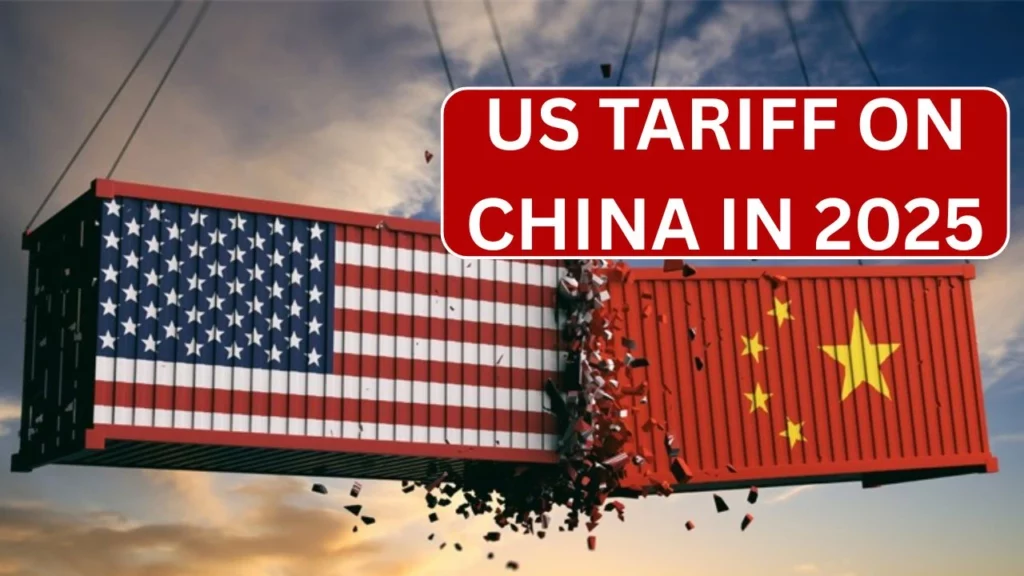A wide range of reciprocal tariffs aimed at the country’s trading partners were announced by US President Donald Trump. The proclamation, which was dubbed “Liberation Day,” was applicable in all 180 countries. Trump imposed a baseline duty of 10% on all imports in addition to duties imposed on individual countries and US Tariff On China In 2025 is set at 54%. Global markets and the US economy are preparing for possible disruptions. The goal of the new policy is to offset trade restrictions put in place by other countries. This post will offer you complete detail about this US Reciprocal Tariff On China In 2025.

US Tariff On China In 2025
The United States imposed a series of increasing tariffs on Chinese imports at the beginning of 2025, claiming trade imbalances and national security concerns. A 10% duty on all Chinese goods will go into effect on February 4th, according to Executive Order 14195, which President Donald Trump signed on February 1st. In response, China imposed 10% tariffs on oil and agricultural equipment and 15% duties on U.S. coal and liquefied natural gas on February 10. China also placed restrictions on the export of specific metals and opened an antitrust inquiry against Google.
On April 2, President Trump issued a broad range of tariffs, including a 34% tariff on Chinese imports, which, when added to earlier charges, raised the overall tariff rate to 54%. US Tariff On China In 2025 further exacerbated the problem. China vowed to take firm action in response to these acts, denouncing them as detrimental. Economists cautioned that these tariffs might have a major effect on China’s economy, with Citigroup projecting a 2.4 percentage point drop in GDP growth in 2025.
US China Tariff Rates 2025
| Article | US Tariff On China 2025 – Announcement |
| Trump’s Declaration | Discounted Reciprocal Tariff |
| USA Tariff Rate On China In 2025 | 54% |
| Tariff Implementation Date | 2 April 2025 |
| Export Affected | Technology, Metal & Other imports |
| Category | Finance |
| Official Site | usa.gov |
US Reciprocal Tariff On China In 2025
Global markets and the US economy are preparing for possible disruptions. The goal of the US Reciprocal Tariff On China In 2025 is to offset trade restrictions put in place by other countries. The key conclusions are as follows:
- With the potential to affect international markets and trade dynamics, the proposed tariffs represent a substantial change in US trade policy.
- China will be subject to a 54 percent tariff overall, with an extra 34 percent on top of the current 20 percent. India will pay a 26 percent tax, while the European Union would pay a 20 percent levy.
- Beginning on April 5, a minimum 10% tariff will be applied to all imported goods entering the US.The rates will rise further on April 9.
- The Trump administration’s evaluation of tariff and non-tariff barriers, such value-added taxes (VAT), that foreign countries impose on US goods serves as the basis for calculating the rates.
- This executive order will not impact Canada or Mexico, which will continue to have their current trade agreements with the United States.
- If certain commodities are already covered or are scheduled to be covered under Section 232 national security duties, they will not be subject to the reciprocal tariffs. These goods include vehicles, steel, aluminum, copper, medicines, semiconductors, and lumber.
China Respond With Equivalent Tariffs
China has imposed its own set of tariffs on important American products in retaliation for the US actions. Here we disclose those important points:
Higher tariffs have been applied on soybeans, corn and pork which are important exports from American farmers to china.
American automakers’ ability to compete is impacted by the increased costs of exporting to China. American tech companies find it more difficult to sell to china manufactures due to the restriction on US made semiconductor components.
Effect On Companies and Customers
Effect On American Companies: Increased expenses for producers Businesses that depend on Chinese components and raw materials will have to pay more which will raise the cost of their final products.
Decreased Exports: American companies who export to China, especially those in the automobile and agriculture industries, may lose money as a result of raising prices and declining demand.
Supply Chain Distribution: Companies may have to look for other suppliers, which might result in extra expenses and delays.
USA China New Tariff Rates 2025
According to the number of resources the continuing trade war will enter a new chapter in 2025. When the US and China impose reciprocal tariffs. The protection of home industries is the goal of these policies, but they come at a high cost to consumers, businesses and the stability of international commerce. For both nations to prevent long term economic harm, their trade policies will need to be properly managed. Whatever we disclose in this blog posts are based on a number of facts and youtube channels report. So if you want to check out official data then you must click on its official page.
FAQs On US Tariff On China In 2025
Why has China been subject to US tariffs?
To defend home industry and combat unfair trade practices.
When did the most recent tariffs go into effect?
Announcements of 2025 policies will determine specific changes.
Which goods from China are subject to US tariffs?
EV batteries, solar panels, steel, electronics, and more.
What is the new tariff amount?
Varies by product, with some going above 25%.
Are China-related tariffs permanent?
No, they could be changed in light of trade negotiations.
These tariffs benefit whom?
US producers and employees in industries under protection.
US tariffs on China have the greatest impact on whom?
US importers/consumers and Chinese exporters.
Will the US trade imbalance decrease as a result of tariffs?
They might, but they run the danger of upsetting international supply systems.
